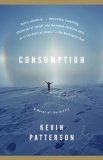Summary | Excerpt | Reading Guide | Reviews | Beyond the Book | Read-Alikes | Genres & Themes | Author Bio

This article relates to Consumption
Rankin Inlet (picture)
has a population of about 2,200.
It is located on the 63rd
parallel on the west shore of
Hudson Bay (map)
approximately 1,100 miles north
of Winnipeg in the recently
formed territory of Nunavut,
which was officially separated
from the Canadian Northwest
Territories in April 1999.
A Short History of the Inuit
According to
nunavut.com, the history of
the Inuit begins in the southern
Bering Sea (North Pacific)
where, about 2 to 3,000 years
ago, an ancient culture adapted
their maritime hunting life to
the seasonally ice-covered
waters of the Bering Sea. Traces
of settlements can be found
complete with splendid carvings
and there are indications that
metal tools had largely replaced
stone.
Between 1,500 and 1,000 years
ago, some of these Inuit groups
learned to hunt bowhead whales,
the largest animals in the
arctic seas. Large communities
were established on points of
land along the northern coast of
Alaska where whales could be
easily hunted as they migrated
through narrow leads in the
spring ice. About 1,000 years
ago, some of these North Alaskan
Inuit spread rapidly eastwards
across arctic Canada and
Greenland (around the same time
that the Scandinavian "Vikings"
attempted to settle Greenland -
see
The Thrall's Tale)
displacing the previous Tuniit
occupants of the region and
establishing the first Inuit
occupation of Nunavut.
About 500 years ago, Inuit
culture in many parts of Nunavut
underwent significant changes
that correspond with the "Little
Ice Age". Most of the High
Arctic regions were abandoned
and many groups gave up whaling
to concentrate on hunting
smaller sea mammals, caribou and
fish. Unable to accumulate
enough food to survive the
winter in permanent villages
they began to winter in igloo
communities from which they
could efficiently hunt seals
through the ice. Around the same
time, European fisherman,
explorers, whalers and traders
began to encroach on the Inuit
lands bringing guns, cloth,
metal, tools, alcohol, tobacco,
religion and disease which were
bartered for furs.
The Inuit are the last of the
indigenous people of North
America to come off the land.
While they lived on the land,
eating a primarily animal
fat/protein diet, diabetes* was
unheard of and heart disease was
rare, but now they are fast
catching up, or even overtaking,
other indigenous groups.
*Worldwide, indigenous people
suffer Type II diabetes at 2-5
times the rate of non-indigenous
people, but scientists disagree
on the reasons. One theory is
the "thrifty gene hypothesis"
that proposes that cycles of
feast and famine have caused
indigenous people's bodies to be
particularly efficient at
storing and using nutrients, a
trait that is unsuited to a
modern sedentary lifestyle with
no shortage of calories. Other
research indicates that genes
are no more important to
indigenous people than for
anyone else and it is poor diet,
reduced physical activity,
stress and other factors
associated with poverty that
contribute to the high rates.
Filed under Places, Cultures & Identities
![]() This "beyond the book article" relates to Consumption. It originally ran in August 2007 and has been updated for the
July 2008 paperback edition.
Go to magazine.
This "beyond the book article" relates to Consumption. It originally ran in August 2007 and has been updated for the
July 2008 paperback edition.
Go to magazine.
Your guide toexceptional books
BookBrowse seeks out and recommends the best in contemporary fiction and nonfiction—books that not only engage and entertain but also deepen our understanding of ourselves and the world around us.